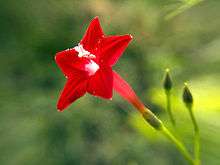Ipomoea quamoclit
- "Cardinal Vine" redirects here. Not to be confused with Cardinal Climber and Cardinal Creeper.
| Ipomoea quamoclit | |
|---|---|
 | |
| Scientific classification | |
| Kingdom: | Plantae |
| (unranked): | Angiosperms |
| (unranked): | Eudicots |
| (unranked): | Asterids |
| Order: | Solanales |
| Family: | Convolvulaceae |
| Genus: | Ipomoea |
| Species: | I. quamoclit |
| Binomial name | |
| Ipomoea quamoclit L. | |
Ipomoea quamoclit (cypress vine, cypressvine morning glory, cardinal creeper, cardinal vine, star glory or hummingbird vine) is a species of Ipomoea morning glory native to tropical regions of the New World from northern South America north to Mexico. In southern India, it is called mayil manikkam in Tamil: மயில் மாணிக்கம். In Malayalam, it is called ākāśamulla. In Assamese it is known as Kunjalata (কুঞ্জলতা). In Bangladesh, it is called Tarulata, Kamalata, Kunjalata, Getphul.[1]
It is an annual or perennial, herbaceous, twining vine growing to 1–3 m tall. The leaves are 2–9 cm long, deeply lobed (nearly pinnate), with 9-19 lobes on each side of the leaf. The flowers are 3–4 cm long and 2 cm in diameter, trumpet-shaped with five points, and can be red, pink or white. It flowers in summer and fall.
Cultivation and uses
It is widely cultivated as an ornamental plant throughout the tropics, and also outside of tropical regions, where it is grown as an annual plant only, not surviving temperate zone winters. In some tropical areas, it has become naturalized.
Seedlings must always be kept moist. They require full sun for good growth. This vine is one of the best plants for attracting hummingbirds, and is a vigorous grower. In warmer climates, this plant can be extremely invasive.
Ipomoea × multifida is a hybrid between I. quamoclit and the cypress vine (I. hederifolia). The allotetraploid of this hybrid is Ipomoea sloteri. Both are known as cardinal climber.
Symbolism
Traditional meanings
Despair.
 Flower
Flower Flowers and foliage
Flowers and foliage Seeds
Seeds- Form
See also
References
| Wikimedia Commons has media related to Ipomoea quamoclit. |
- ↑ "IPOMOEA QUAMOCLIT L.". Medical Plants BD.
- Germplasm Resources Information Network: Ipomoea quamoclit
- Haque, S. M. and B. Ghosh. (2013). In vitro completion of sexual life cycle: production of R1 plants of Ipomoea quamoclit L. Propag. Ornam. Plants 13, 19-24.